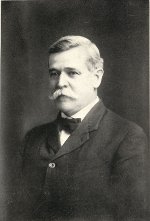
Judge Saunders was born in Campbell County, Virginia, on July 25, 1853, and earned his LL.B. at the University of Virginia in 1873. He practiced law in Galveston, Texas, for two years, then moved to New Orleans, where he married Laura M. Barelli Saunders in 1884 and practiced law for more than 30 years. In the early 1890s, he was a partner in the influential law firm of White, Parlange & Saunders. His law partners were Edward D. White (later Associate Justice of the United States Supreme Court) and Charles Parlange (later Judge Saunders' predecessor on the Eastern District trial bench).
In the late 1890s, in addition to his private law practice, Judge Saunders became Professor of Common Law and Equity and, later, Dean of the Tulane Law School. The 1908 Tulane University Jambalaya yearbook was dedicated to him. The Dedication said that Judge Saunders was "a man whose unselfish devotion to the ... [law] department deserve more than a mere curt passing note.... [H]e was the prime mover in the reorganization of the School .... From several generations of dry rot, the Tulane Law School is today an aged but flourishing infant of the twentieth century, destined to become the leading civilian school of law in the United States. To Judge Saunders is this prosperity due ... The highest praise would be too slight for him, ..."
Judge Saunders was the author of several law books, including a textbook on tax law, an annotated version of the Louisiana Civil Code, and a book of Notarial and Judicial Forms. In 1925, the Regent of the Loyola University School of Law said Judge Saunders was "acknowledged to be the greatest student of the civil law during his time."
Although he was a Democrat, Judge Saunders was nominated to his judgeship by President Theodore Roosevelt on February 11, 1907. He was confirmed by the Senate and received his commission on February 20, 1907, but he served as a judge for only two years, resigning on February 8, 1909. In reporting that he died on October 27, 1914 in Virginia, The Times-Picayune wrote about Judge Saunders' resignation: "Accepted appointment at considerable personal sacrifice because his law practice was heavy. Resigned to resume practice."
Judge Saunders' stature in the Louisiana legal profession was enormous and longlasting. When the legendary Civil Law Professor Ferdinand Fairfax Stone attacked the judge's published view that Louisiana tort law had "practically no connection with Roman, French or Spanish laws," Stone did so only with a careful analysis and a diplomatic introductory caveat that acknowledged the "high place( )... important authors(hip)... learning and position of him who asserted the alleged error... ," even though Judge Saunders had died 28 years earlier. 16 Tulane Law Review 489 (1942).
